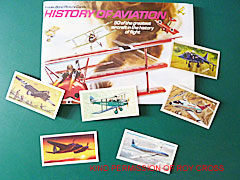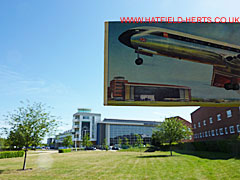 Roy Cross – Part 2
(1944-1974)
Roy Cross – Part 2
(1944-1974)
1944 – By now, Roy was also working in Fairey's factory producing engines. Roy, who had continued to contribute work to the ATC Gazette, was invited to join its staff by the editor Leonard Taylor. During his time here he also sent articles to Flight magazine and Aeronautics (edited by Major Oliver Stewart). While Roy had started out with illustrations he also wrote the text for a number of articles, some used photos rather than illustrations (it was only much later that Roy abandoned writing to concentrate solely on the art side).
Click here for the John Stroud feature
Post-WWII
Roy left the ATC Gazette and joined a commercial art studio, Technical Designs Ltd, based at Queen Anne's Gate, London. Here he learnt airbrush techniques.
1945-46 – produced a series of artworks (including a cutaway of the de Havilland Dove) for Air Review, edited by D A Russell. Roy's Dove drawing was later used by de Havillands in one of their sales brochures.
May 1946 – last edition of the Air Training Corps Gazette (it became the Air Reserve Gazette the following month). The lead article was by Roy and featured the DH.103 Hornet. It covered 3-pages and included photos and plan views. It is likely that Roy would have travelled to Hatfield for this piece although he can't remember the date (an article by him on the Miles Magister appeared in the July edition of the newly titled Air Reserve Gazette).
1947 – Left Fairey Aviation for the final time, and became a freelance artist. From now on until he started working for Airfix, he would undertake a wide range of work for a variety of clients. In this respect he was following in the footsteps of other industrial master artists like Frank Wootton and Terence Cuneo (both men whose work he admired and picked up valuable tips from – and who have Hatfield connections. Roy remembers attending Terence Cuneo's last exhibition at the Mall Gallery, and the artist looking around at a room full of his paintings and saying wonderingly: "Did I really do all these?").
Through various work assignments Roy met several boyhood heroes: WWII fighter ace Robert Stanford Tuck who was working at Ferranti; Joseph Smith at Supermarine (responsible for developing the later versions of R J Mitchell's iconic Spitfire). He also met Spitfire test pilot Jeffrey Quill and Spitfire ace Douglas Bader at Vickers, Weybridge.
He had an article on the new American trainer, the Fairchild XNQ-1, published in a November edition of Flight magazine.
1948 – Produced work for US aviation publications Aviation Week and Aero Digest. Also for the British publication, Aeroplane Spotter. This led to some jobs with Aeroplane (together with Flight magazine were the two most prestigious UK aviation titles).
1951 – Produced cutaways for the then new Routemaster bus (built by a number of different manufacturers, his visual guides helped the maintenance staff), and a Morris Minor owner's manual. Also produced work for the de Havilland and Hawker Siddeley aircraft companies and an aero engine guide for Blackburn Bombardier.
1952 – Roy married Rita May Purnell in Gloucester. Later, they had a son – Anthony John Cross.
Post-war austerity led to Government cuts in the aviation industry and work drying up. Roy introduced himself to London advertising agencies. Among his wide range of commissions was his first boardroom commission for his former employers Fairey Aviation. This painting of the Fairey Delta II prototype WG774 on its maiden flight on 6 October 1954 is now in the Fleet Air Arm Museum collection. The commission motivated Roy to undertake formal studies on oil-painting (the usual fine art medium).
1954 – Society of Aviation Artists (SAA) formed. Roy elected as one of the original painter-members. He joined the ranks of Norman Wilkinson (first president), Frank Wootton (first vice president), Terence Cuneo, Roy Nockolds, Gerald Coulson, John Young, Keith Shackleton, and David Sheperd (the Society became part of the Industrial Painters' Group in 1961).
1955 – The Jet Aircraft of the World, a book illustrated by Roy published. A solo work, Supersonic Aircraft, was also published.
1956 – produced a booklet for Shell Oil, 'Know Your Airliners' (among the aircraft featured are several de Havilland designs: Dove, Dragon Rapide, Heron series II, Comet 4, and the Airspeed Elizabethan), which led to an offer of further commissions from Shell but Roy didn't feel he was ready to do them so refused.
1957 – Roy's painting of four Hawker designs (Hunter, Tempest, Hurricane and Fury) was used by Hawker Aircraft for their corporate Christmas card.
Late 1950's – Course at St Martin's School of Art (he had previously taken a course at the Camberwell School of Arts and Crafts, which helped him 'graduate' from line drawings to colour work, which him to produce colour artworks for aviation companies, like Hawker Aircraft, which appeared in Flight and The Aeroplane). Here he learnt about art history and picked up on some useful oil-painting techniques.
1962 – Early Aircraft 1907 to 1918 – a book by Roy featured side view drawings of 12 aircraft, starting with the Wright-Flyer. He also had another book The Fighter Aircraft Pocketbook published this year (mainly uses photographs).
Was commissioned to produce a series of racing car artworks for publication in the Eagle, a boys' comic. Also produced aviation artworks for the covers of another boys' comic, Swift (Roy's book, Celebration of Flight shows an example edition dated 7 April 1962). However, both of these contracts were eventually cancelled and Roy found himself at a loose end.
Having worked on the ATC Gazette and with many of his early books aimed at a younger audience, Roy had developed an unerring instinct for what appealed to them. Seeing some Airfix kits in a branch of Woolworths and deciding he could improve the box art, he submitted some speculative work to them. Charlie Oates, their original artist was in poor health and Roy was engaged. It was the start of a decade-long collaboration and Roy's transition from commercial to fine artist.
Airfix years
1964-74 – Worked for Airfix Products Limited. Roy mainly worked on the aviation products side, although he did work for other areas like ships (including the Golden Hind, HMS Ark Royal, Prinz Eugen, and Canberra) and vehicles (including the Mark I tank and the Monty's Humber staff car). Airfix also engaged other artists, like Brian Knight – responsible for classic ship range and some of the scale soldier boxes.
Roy went on produce artworks for a number of Hatfield-related aircraft kits, including: DH.82A Tiger Moth; DH.88 Comet; DH.98 Mosquito (FB VI, XVIII, and the 'Dogfight Double' version with the Me.262); DH.114 Heron; DH.106 Comet 4; HS Trident and the HS 125 Dominie. He also did the artwork for the 1/24 scale Hawker Hurricane bearing the markings of British fighter ace Ian Gleed, who learnt to fly at Hatfield.
Click here for the W/C I R Gleed feature
In the process, Roy has immortalised Hatfield in his box artwork for the Airfix DH Comet 4. The housing on the right is on the site of the former BAe146 Hangar
Click here for the Flight Test Hangar feature
Click here for the BAe146 Hangar feature
7 January 1964 – date of Roy's first invoice to Airfix.
1971 – The first in an Airfix-related series of aircraft history and modelling books was published. 'Spitfire' was co-written with Gerald Scarborough, who also worked with Roy on books on the Messerschmitt Bf109 (1972) and the North American P51 Mustang (1973).
Roy also had two solo books released: Great Aircraft and Their Pilots (which among others featured the 1934 MacRobertson England to Australia Race winners C W A Scott and Tom Campbell Black and their de Havilland DH.88 Comet Racer, Grosvenor House – assembled and first flown at Hatfield), and Military Aircraft 1939-1945. Both were issued by publisher Hugh Evelyn.
 1972 – Illustrated Brooke Bond picture cards / collectors' cards
and album in their 'History of Aviation' series (image at the
top of this page). Among the aircraft
featured in the set of 50 cards are Hatfield-built designs: DH.98
Mosquito, DH.106 Comet, and HS.125. While the album includes a line
drawing of a DH.82A Tiger Moth.
1972 – Illustrated Brooke Bond picture cards / collectors' cards
and album in their 'History of Aviation' series (image at the
top of this page). Among the aircraft
featured in the set of 50 cards are Hatfield-built designs: DH.98
Mosquito, DH.106 Comet, and HS.125. While the album includes a line
drawing of a DH.82A Tiger Moth.
1973 – Roy took part in a five-man exhibition of sail paintings organised by the Malcolm Henderson Gallery, St James's Street, London (the other artists were: Charles Madden, Terence Storey, John Worsley, and John Webster). It marked the beginning of the end of Roy's initial aviation art phase and the start of his marine period.
Ironically, it was a 'thank you' gift to Airfix colleagues (managing director John Gray and chief buyer Charles Smith) that helped steer Roy on the path to becoming a marine artist. A visitor had admired Roy's gift and had pointed out that such talent was better suited to the fine arts. Charles Smith told Roy, who did some research and identified Malcolm Henderson's gallery as specialising in maritime art. He paid him an initial visit and then returned with six of what Malcolm Henderson would later describe as "magnificent scenes of sailing ships at sea". He promptly bought the lot and invited Roy to take part in the exhibition. All of Roy's paintings sold. Around six months later he informed Roy that he had secured enough commissions that he had better resign from Airfix (which in any case was scaling back following the massive increase in oil prices – needed to make plastic – that were a result of the blocking of the Suez Canal in the 1973 Yom Kippur War and OPEC oil embargo).
August 1974 – Roy's last invoices to Airfix (after having introduced Kenneth McDonough to replace him). There was some uncertainty as to whether Roy's last job for Airfix was for a WWII warship, Prinz Eugen, or a modern jet airliner, the Airbus A300, as the jobs were part of a batch. However, when asked earlier this year (2012), Roy said he thought his last Airfix commission was the Airbus.
In total, Roy estimates that he produced over 200 finished paintings and even more rough artworks and other material during his time at Airfix. Most of these are believed to have been discarded after colour transparencies were created or lost in the various offices moves and upheavals that Airfix went through. However, some are said to have been given as leaving presents to Airfix employees (and it is also believed that some were saved by employees who took a fancy to them). The RAF Museum is planning an aviation art exhibition, together with Airfix, in 2013 and it will be interesting to see how many 'lost' works surface.
Back to: Features on Hatfield12 October 2012
